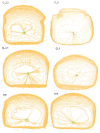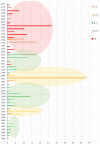Extracts with Nutritional Potential and Their Influence on the Rheological Properties of Dough and Quality Parameters of Bread
- PMID: 38338518
- PMCID: PMC10855696
- DOI: 10.3390/foods13030382
Extracts with Nutritional Potential and Their Influence on the Rheological Properties of Dough and Quality Parameters of Bread
Abstract
Formulating basic food to improve its nutritional profile is one potential method for food innovation. One option in formulating basic food such as bread is to supplement flours with specified amounts of non-bakery raw materials with high nutritional benefits. In the research presented here, we studied the influence of the addition of curcumin and quercetin extracts in amounts of 2.5% and 5% to wheat flour (2.5:97.5; 5:95). The analysis of the rheological properties of dough was carried out using a Mixolab 2. A Rheofermentometer F4 was used to assess the dough's fermentation, and a Volscan was used to evaluate the baking trials. The effect of the extracts on the rheological properties of dough was measured and found to be statistically significant, with curcumin shortening both dough development time and dough stability. Doughs made with greater quantities of extract had a greater tendency to early starch retrogradation, which negatively affects the shelf life of the end products. The addition of extracts did not significantly affect either the ability to form gas during fermentation or its retention, which is important because this gas is prerequisite to forming a final product with the required volume and porosity of crumb. Less favourable results were found on sensory evaluation, wherein the trial bread was significantly worse than the control wheat bread. The panel's decision-making might have been influenced by the atypical colour of the bread made with additives, and in case of a trial bread made with quercetin, by a bitter taste. From the technological point of view, the results confirmed that the composite flours prepared with the addition of extracts of curcumin and quercetin in amounts of 2.5% and 5% can be processed according to standard procedures. The final product will be bread with improved nutritional profile and specific sensory properties, specifically an unconventional and attractive colour.
Keywords: Mixolab; Rheofermentometer; baking test; curcumin; dough rheology; quercetin; sensory evaluation.
Conflict of interest statement
The authors declare no conflicts of interest. The funders had no role in the design of the study; in the collection, analyses, or interpretation of data; in the writing of the manuscript, or in the decision to publish the results.
Figures














Similar articles
-
Effects of Adding Legume Flours on the Rheological and Breadmaking Properties of Dough.Foods. 2021 May 14;10(5):1087. doi: 10.3390/foods10051087. Foods. 2021. PMID: 34068906 Free PMC article.
-
Effects of whey and soy protein addition on bread rheological property of wheat flour.J Texture Stud. 2018 Feb;49(1):38-46. doi: 10.1111/jtxs.12275. Epub 2017 May 25. J Texture Stud. 2018. PMID: 28472867
-
Bambara-wheat composite flour: rheological behavior of dough and functionality in bread.Food Sci Nutr. 2016 Mar 4;4(6):852-857. doi: 10.1002/fsn3.356. eCollection 2016 Nov. Food Sci Nutr. 2016. PMID: 27826435 Free PMC article.
-
Influence of replacing wheat bran with barley bran on dough rheology, digestibility and retrogradation behavior of chapatti.Food Chem. 2018 Feb 1;240:1154-1160. doi: 10.1016/j.foodchem.2017.08.042. Epub 2017 Aug 16. Food Chem. 2018. PMID: 28946237 Review.
-
Technological and Nutritional Aspects of Bread Production: An Overview of Current Status and Future Challenges.Foods. 2024 Jun 28;13(13):2062. doi: 10.3390/foods13132062. Foods. 2024. PMID: 38998567 Free PMC article. Review.
Cited by
-
Unrevealing the mechanisms behind the cardioprotective effect of wheat polyphenolics.Arch Toxicol. 2024 Nov;98(11):3543-3567. doi: 10.1007/s00204-024-03850-y. Epub 2024 Aug 31. Arch Toxicol. 2024. PMID: 39215839 Review.
-
Phenols Extraction from Sorghum Byproducts: Upcycling Strategies and Food Applications.Antioxidants (Basel). 2025 May 30;14(6):668. doi: 10.3390/antiox14060668. Antioxidants (Basel). 2025. PMID: 40563302 Free PMC article.
References
-
- DATACube, Statistical Office of Slovak Republic. 2023. [(accessed on 10 December 2023)]. Available online: https://datacube.statistics.sk/
-
- Bender D., Schönlechner R. Innovative Approaches towards Improved Gluten-Free Bread Properties. J. Cereal Sci. 2020;91:102904. doi: 10.1016/j.jcs.2019.102904. - DOI
-
- Mitelut A.C., Popa E.E., Popescu P.A., Popa M.E. Trends in Wheat and Bread Making. Academic Press; Cambridge, MA, USA: 2021. Trends of Innovation in Bread and Bakery Production; pp. 199–226. - DOI
-
- Silva A.F.R., Monteiro M., Nunes R., Baião A., Braga S.S., Sarmento B., Coimbra M.A., Silva A.M.S., Cardoso S.M. Bread Enriched with Resveratrol: Influence of the Delivery Vehicles on Its Bioactivity. Food Biosci. 2022;49:101887. doi: 10.1016/j.fbio.2022.101887. - DOI
-
- Dziki D., Różyło R., Gawlik-Dziki U., Świeca M. Current Trends in the Enhancement of Antioxidant Activity of Wheat Bread by the Addition of Plant Materials Rich in Phenolic Compounds. Trends Food Sci. Technol. 2014;40:48–61. doi: 10.1016/j.tifs.2014.07.010. - DOI
Grants and funding
LinkOut - more resources
Full Text Sources

